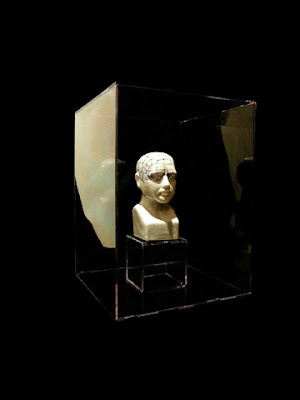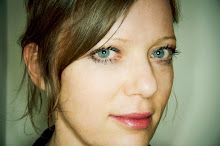Seeing Ourselves
Curated by KJ Baysa and Caitlin Hardy
MuseCPMI
850 Eighth Avenue
New York, NY 10018
www.musecpmi.org
March 2 - April 14th 2012
Opening reception March 10th, 7-9 pm
Anne Katrine Senstad
Title: Organ of Ideality, 2012
Size: 12 x 12 x 16 inches
Edition: 1/1
“The forehead is broad, with prominent organs of ideality”
Edgar Allen Poe, 1846
The science of Phrenology was originally developed by the German physician Franz Joseph Gall in 1792, giving his scientific discoveries on localized regions of the cerebral cortex where the innate universal faculties resided, the title “Doctrine of the skull”. With his ideas of localization, Gall was the first person to create a theory of localized mental illness, that suggested that the mental conditions could be localized in the brain.
The science of Phrenology and of the mind that Gall further developed explores the connection between the dimensions of the skull and personality characteristics organized into a systematic hierarchical classification system. By the 1830’s in America, Orson Squire Fowler developed practical Phrenology by opening the first Phrenology office at 135 Nassau Street in Manhattan where he and his assistants read heads, gave lectures and trained a fleet of bright eyed young Phrenologists.
In Victorian literary circles, writers were great fans of Phrenology and found phrenological language useful for describing personality or in dialogue. This Phrenological language can be found in the authorship of Walt Whitman, Edgar Allen Poe, Victor Hugo, Herman Melville and Charles Dickens to mention a few. By 1843 phrenology began to be referred to as pseudoscience.
“The forehead is broad, with prominent organs of ideality”
Edgar Allen Poe, 1846
The science of Phrenology was originally developed by the German physician Franz Joseph Gall in 1792, giving his scientific discoveries on localized regions of the cerebral cortex where the innate universal faculties resided, the title “Doctrine of the skull”. With his ideas of localization, Gall was the first person to create a theory of localized mental illness, that suggested that the mental conditions could be localized in the brain.
The science of Phrenology and of the mind that Gall further developed explores the connection between the dimensions of the skull and personality characteristics organized into a systematic hierarchical classification system. By the 1830’s in America, Orson Squire Fowler developed practical Phrenology by opening the first Phrenology office at 135 Nassau Street in Manhattan where he and his assistants read heads, gave lectures and trained a fleet of bright eyed young Phrenologists.
In Victorian literary circles, writers were great fans of Phrenology and found phrenological language useful for describing personality or in dialogue. This Phrenological language can be found in the authorship of Walt Whitman, Edgar Allen Poe, Victor Hugo, Herman Melville and Charles Dickens to mention a few. By 1843 phrenology began to be referred to as pseudoscience.
Other artists in the exhibition:
Suzanne Anker, Deborah Aschheim, Stephen Auger, Christophe Bedaguer and Marie Pejus with Christophe Laudamiel and Christoph Hornetz, Stefani Bardin and Toby Heys, Jonathan Beer, Nancy Burson, Naomi Campbell, caraballo-farman, Joyce Cutler-Shaw, Scott Draves, Simon Drouin, Greg Dunn, Laura Ferguson, Angela Freiberger, Pablo Garcia, Sarah Elise Hall, Hugh Hayden, Pinkney Herbert, Nene Humphrey, Elizabeth Jameson, Sophie Kahn, Andrea Kantrowitz, Mark Kessell, Adrienne Klein, Bodo Korsig, Lilla LoCurto and Bill Outcault, Marcos Lutyens, Kate MacDowell, Michael Madore, Daniel Margulies and Chris Sharp, Patrick Martinez, Saul Melman, Igor Molochevski, Gayil Nalls, Natsu, Francesca Samsel, Anne Katrine Senstad, Jason Snyder, Max Steiner, Satre Stuelke, Visual MD, Claire Watkins, David Webster, Heron Werner MD with Professors Jorge Lopes dos Santos and Ricardo Fontes, Graham Wiggins, Virgil Wong with Jessica Lacson and Akshay Kapur










